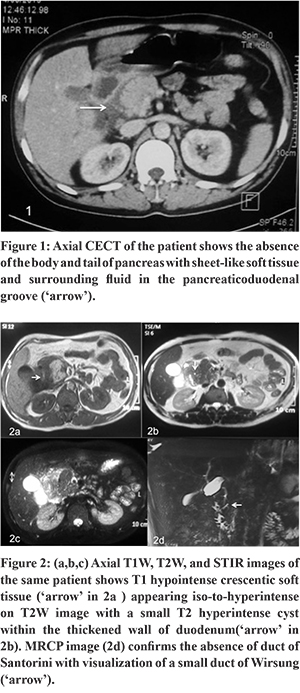48uep6bbphidcol2|ID
48uep6bbphidvals|1909
48uep6bbph|2000F98CTab_Articles|Fulltext
Developmental anomalies of the pancreas are well known. However, complete agenesis of the dorsal pancreas is an extremely rare malformation. These anomalies predispose to episodes of pancreatitis; groove pancreatitis is the least common form of acute pancreatitis encountered in clinical practice. We present a case of a young male who suffered from both of these rare entities.
Case Report
A 28 year-old male presented with a history of recurrent attacks of peri-umbilical pain for the last 4 months. The patient was non-diabetic and non-alcoholic. Serum amylase and lipase were elevated. CECT abdomen was performed with suspicion of pancreatitis, which revealed normally enhancing head and uncinate process and non-visualization of body and tail of pancreas, consistent with agenesis of dorsal pancreas (ADP) (Figure 1). An abnormal crescentic soft tissue with surrounding mild fluid was noted in the pancreatico-duodenal groove. Subsequently, an MRI was performed, which mirrored well with CT findings showing sheet-like T1 hypointense soft tissue appearing iso-hyperintense on T2W and STIR images in the pancreatico-duodenal groove along with tiny T2 hyperintense cysts in the thickened medial wall of the duodenum (Figure 2). MRCP images confirmed the absence of duct of Santorini with visualization of a small duct of Wirsung draining in major papilla along with the common bile duct without evidence of biliary calculi or dilatation. These imaging findings were strongly suggestive of groove pancreatitis. EUS guided FNAC was negative for malignancy. The patient was managed conservatively and showed resolution of symptoms in a few weeks. This case represents a novel association of groove pancreatitis with agenesis of the dorsal pancreas.

Discussion
ADP is among the least common of the reported pancreatic anomalies1,2. Although cases of acute and chronic pancreatitis associated with dorsal pancreatic agenesis have been reported, the finding of groove pancreatitis is a new association. Failure of the dorsal bud to form the body and tail of pancreas results in dorsal pancreatic agenesis, giving rise to characteristic “dependent intestine sign” and “dependent stomach sign” on imaging. These occur because of the absence of pancreatic tissue in the region of body and tail with the potential space anterior to the splenic vein being occupied by bowel loops3,4. More common entities, including pseudo-agenesis due to autodigestion of body and tail secondary to chronic pancreatitis and fatty replacement of pancreas, have to be differentiated. MRCP confirms the same by demonstrating complete absence of duct of Santorini, obviating the need for ERCP which is an invasive procedure.
Imaging features of groove pancreatitis include the presence of crescentic sheet-like soft tissue in the pancreaticoduodenal groove. Few tiny dystrophic cysts may also be found in the medial wall of the duodenum, as in our case. No involvement of the head of pancreas is seen in the “pure” form of groove pancreatitis. As opposed to it, the head of pancreas is involved in the segmental form, often presenting with mass-like enlargement of the head. Every effort has to be made to differentiate it from adenocarcinoma of head of pancreas, which may not be possible in every case5.
The co-occurrence of two extremely rare entities, that is, complete agenesis of the dorsal pancreas (ADP) and groove pancreatitis, is hitherto unknown, this being the first such case.
References
- Kabnurkar R, Rokade ML, Bandekar K et al. Incidentally detected agenesis of dorsal pancreas on PET/CT: Case report and review of literature. Indian J Nucl Med 2017;32:33-5.
- Ranjan K Sahoo, Srikant K. Dhar, Pratap Beher Dorsal pancreas agenesis - a rare case report, Eur. J. Anat. 19 (3): 291-293 (2015)
- Thakur S, Jhobta A, Sharma D et al MR in complete dorsal pancreatic agenesis: Case report and review of literature Indian J Radiol Imaging 2014; 24:156-9?
- Manoranjan Mohapatra, Sanjeet Mishra, Prakash Chandra Dalai et al Imaging Findings in Agenesis of the Dorsal Pancreas. Report of Three Cases JOP. J Pancreas (Online) 2012 Jan 10; 13(1):108-114.
- Siva P. Raman Safia N. Salaria,Ralph H. Hruban et al Groove Pancreatitis: Spectrum of Imaging Findings and Radiology- Pathology Correlation AJR 2013; 201:W29–W39